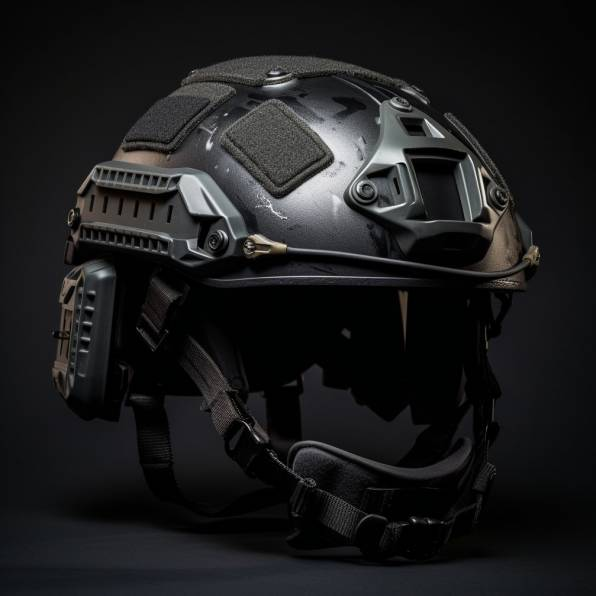Ballistic helmets play a crucial role in the gear of military and law enforcement personnel involved in tactical operations. A properly chosen helmet not only shields the wearer from various ballistic threats but also ensures comfort and a secure fit.
By carefully evaluating these factors, you can confidently choose the optimal ballistic helmet for any tactical scenario.
Identifying Your Tactical Requirements
When choosing a ballistic helmet, it’s crucial to assess the required levels of ballistic protection based on threat levels.
Additionally, consider mission types and roles to ensure the helmet meets operational needs.
Evaluate compatibility with communication devices and accessories to ensure seamless integration.
Assessing Threat Levels and Ballistic Protection
Considering the diverse range of threat levels, it is crucial to ensure that a ballistic helmet offers the necessary level of protection.
Ballistic helmets are categorized based on the specific threats they are designed to withstand and their corresponding resistance levels. Typically, they fall into two main categories: those engineered to defend against handgun fire, and those built to withstand high-powered rifle fire.
Handgun-rated helmets are typically graded on a scale from I to III, with III providing the highest level of protection. High-powered rifle-rated helmets are usually rated from IIIa to IV, with IV offering the highest protection level. Additionally, some helmets are designed to provide protection against fragmentation, in addition to ballistic threats.
When selecting a ballistic helmet, it is crucial to assess the likely threats and select a helmet that matches the required protection level. Proper fit and comfort for extended wear should also be prioritized.
Lastly, it is important to monitor the helmet’s expiration date, as ballistic helmets degrade over time and should be replaced accordingly.
Considering Mission Types and Roles
Different mission types and roles necessitate varying levels of ballistic protection. When choosing the appropriate ballistic helmet, it is crucial to take into account the specific mission and the user’s role.
For instance, a law enforcement officer involved in arrest operations may require a lightweight helmet suitable for close-quarters combat. In contrast, a soldier engaged in battlefield scenarios may need a heavier, more durable helmet. The mission type and role can also influence factors like helmet thickness, the level of protection provided, and the incorporation of specific features.
A lighter helmet might offer sufficient protection against lower-level threats such as shrapnel but may not be adequate against more serious threats like rifle fire. Conversely, a heavier helmet could provide enhanced protection, but its bulk and weight may pose challenges for certain roles or missions.
Careful consideration of the mission type and user role is essential for making a well-informed decision when selecting a ballistic helmet.
Assessing Compatibility with Communication Devices and Accessories
Before choosing a ballistic helmet, it is crucial to assess its compatibility with communication devices and accessories.
Ballistic helmets are not only designed for protection but can also be equipped with features like radio communication devices and night vision goggles.
Consider the following factors when making your selection:
- Type of radio communication device: Helmets must be compatible with specific makes and models of radio communication devices.
- Helmet size and shape: Different helmets come in various sizes and shapes, and the chosen helmet must fit well with the communication device and accessories.
- Type of night vision goggles: Helmets need to be compatible with the specific type of night vision goggles used.
By evaluating the compatibility of a ballistic helmet with communication devices and accessories, you ensure optimal performance and safety during operations.
The right combination of helmet and accessories enhances the efficiency and effectiveness of tactical missions.
Considering Mission Types and Roles
Different mission types and roles necessitate varying levels of ballistic protection. Choosing the appropriate ballistic helmet involves considering the specific mission and user role.
For instance, a law enforcement officer engaged in arrest operations might require a lightweight helmet suitable for close-quarters combat. Conversely, a soldier deployed in combat scenarios might opt for a heavier, more resilient helmet. Additionally, the mission type and role influence helmet thickness, protective capabilities, and incorporated features.
While a lighter helmet can adequately protect against lower-level threats like shrapnel, it may not offer sufficient defense against more serious hazards such as rifle fire. Conversely, a heavier helmet may provide enhanced protection, yet its bulk and weight could hinder performance in certain roles or missions.
Careful assessment of the user’s mission requirements and operational role is crucial for making a well-informed choice when selecting a ballistic helmet.
Evaluating Compatibility with Communication Devices and Accessories
Assessing the compatibility of a ballistic helmet with communication devices and accessories is crucial before making a selection.
While ballistic helmets primarily offer protection, they can also integrate features such as radio communication devices and night vision goggles.
Consider the following factors when choosing a helmet:
- Type of Radio Communication Device: Different makes and models of radio devices are available, requiring compatibility with the specific device used.
- Helmet Size and Shape: Helmets come in various sizes and shapes, necessitating compatibility with the communication device and other accessories.
- Type of Night Vision Goggles: Various types of night vision goggles exist, and the helmet must accommodate the specific type being utilized.
By evaluating these aspects, you ensure the ballistic helmet’s compatibility with communication devices and accessories, enhancing overall operational efficiency and safety during tactical missions.
Understanding Ballistic Helmet Materials and Ratings
To comprehend the variety of materials, protection levels, and trade-offs associated with ballistic helmets, it is essential to gain an overview of the common materials utilized in their construction.
Additionally, the National Institute of Justice (NIJ) has established standards that indicate a helmet’s capability to provide protection.
Finally, factors such as weight, protection level, and comfort must all be taken into account when selecting the appropriate helmet for tactical requirements.
Overview of Common Helmet Materials
Ballistic helmets are constructed using diverse materials that impact their effectiveness, durability, and comfort. Among the more prevalent materials used are:
- Polyethylene: Known for its lightweight nature and durability, polyethylene is commonly employed in ballistic helmet construction. It excels in shock absorption and can endure impacts effectively.
- Aramid Fibers: These synthetic fibers are lightweight yet robust, making them ideal for ballistic helmets. They boast exceptional shock absorption properties.
- Steel: Steel is a heavy-duty material often utilized in ballistic helmets due to its durability and ability to withstand impacts. However, its weight can result in discomfort during extended use.
Each material offers distinct advantages, and the choice of material should align with specific tactical needs and environmental conditions. Conducting thorough research is crucial to selecting a helmet that meets all necessary criteria.
NIJ Ballistic Helmet Protection Levels
Understanding the National Institute of Justice’s (NIJ) ballistic helmet protection levels is crucial when selecting the appropriate helmet for specific applications. The NIJ has defined four distinct helmet protection levels to serve as a comprehensive guide for tactical purposes. Level I helmets are designed to mitigate impact forces from blunt trauma, while Level II helmets protect against fragmentation caused by handgun rounds. Level III helmets provide defense against rifle rounds, and Level IV helmets are designed to resist armor-piercing rounds.
Trade-offs between Weight, Protection, and Comfort
When evaluating various ballistic helmets, it is essential to recognize the trade-offs among weight, protection, and comfort. While some helmets may offer higher levels of protection, they can also be heavier and less comfortable to wear. Conversely, lighter helmets may sacrifice some protection for improved comfort.
Therefore, selecting the right helmet involves striking a balance among these factors based on the user’s specific needs and preferences.
Ballistic helmets can be constructed from a range of materials, including Kevlar, Polyethylene, and Polycarbonate. Each material has distinct characteristics such as weight, level of protection, and comfort. Evaluating the pros and cons of each material is crucial to determining which best aligns with the user’s requirements.
Furthermore, helmet fit is critical in ensuring both comfort and protection. A properly fitted helmet enhances overall effectiveness and user comfort.
Helmet Fit, Comfort, and Adjustability
When choosing a ballistic helmet, assessing its fit, comfort, and adjustability is paramount.
Proper Sizing and Fit for Ballistic Helmets
Ensuring correct sizing and fit is crucial for the optimal safety and performance of a ballistic helmet. An improperly fitting helmet can be uncomfortable, distracting, and compromise protection levels.
Measure your head circumference starting from the forehead around to the back. Additionally, measure the distance from your forehead’s front to the back of your head, from the nose’s tip. Using these measurements, consult the manufacturer’s sizing chart to determine the best helmet size for your head shape and size. Ensuring the helmet isn’t too tight or loose is crucial as it affects protection levels.
Depending on the helmet design, you may adjust the fit using straps or padding to achieve a snug yet comfortable fit.
Padding and Suspension Systems
Following proper sizing, consider the helmet’s padding and suspension systems. These components are vital for comfort, stability, and protection against impact.
Types of Padding and Suspension Systems: Ballistic helmets feature various padding types like foam, gel, and air, each with unique benefits and drawbacks tailored to tactical needs. Suspension systems, ranging from simple straps to complex designs, offer additional stability and comfort.
Weight Considerations: Helmet weight is critical; heavier helmets may cause fatigue and discomfort. Opting for a lightweight helmet ensures necessary protection without straining the neck and shoulders.
Durability: Choose helmets crafted from durable materials capable of withstanding shocks, impacts, and regular wear. High-quality materials enhance longevity and offer superior protection.
Ventilation and Moisture Management
Effective ventilation and moisture management are crucial for helmet selection. Adequate ventilation ensures user comfort while maintaining protective capabilities. Well-ventilated helmets facilitate airflow, preventing heat buildup and ensuring moisture wicks away from the face to prevent fogging. Air exchange capability further aids in maintaining a cool head and enhances overall comfort.
Ballistic Helmet Cover Options
The discussion of rail systems for attaching accessories highlights the importance of using a ballistic helmet cover.
A ballistic helmet cover is essential for specific tactical requirements to maintain the helmet’s optimal condition, ensuring user safety and comfort.
These covers provide added protection and camouflage, enabling the helmet to blend into the surroundings effectively for tactical operations.
They are crafted from various materials like nylon and neoprene and are available in diverse colors and patterns to cater to different camouflage and protection needs.
Furthermore, ballistic helmet covers can feature additional attributes such as pockets for extra storage and enhanced protective capabilities.
When choosing a cover, users should consider the operational environment to select the most suitable option.
Conclusion
When selecting a ballistic helmet, meticulous consideration of fit, comfort, and adjustability is essential for ensuring optimal performance and safety. Proper sizing, effective padding and suspension systems, ventilation, and compatibility with accessories all contribute to selecting the right helmet for tactical needs.





